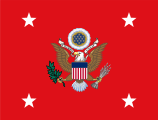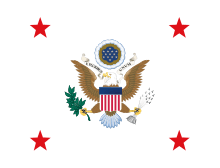Edwin M. Stanton
| Edwin M. Stanton | |
|---|---|
 | |
| 27th United States Secretary of War | |
| In office January 20, 1862 – May 28, 1868 | |
| President | Abraham Lincoln Andrew Johnson |
| Preceded by | Simon Cameron |
| Succeeded by | John M. Schofield |
| 25th United States Attorney General | |
| In office December 20, 1860 – March 4, 1861 | |
| President | James Buchanan |
| Preceded by | Jeremiah S. Black |
| Succeeded by | Edward Bates |
| Personal details | |
| Born | Edwin McMasters Stanton December 19, 1814 Steubenville, Ohio, U.S. |
| Died | December 24, 1869 (aged 55) Washington, D.C., U.S. |
| Resting place | Oak Hill Cemetery, Washington, D.C. |
| Political party | Republican |
| Other political affiliations |
Democratic |
| Spouse(s) | Mary Lamson Stanton Ellen Hutchison Stanton |
| Alma mater | Kenyon College |
| Profession | Lawyer, Politician |
| Religion | Methodist |
| Signature | |
Edwin McMasters Stanton (December 19, 1814 – December 24, 1869) was an American lawyer and politician who served as Secretary of War under the Lincoln Administration during most of the American Civil War. Stanton's effective management helped organize the massive military resources of the North and guide the Union to victory. He also organized the manhunt for Lincoln's killer, John Wilkes Booth.
After Lincoln's assassination, Stanton remained as the Secretary of War under the new President Andrew Johnson during the first years of Reconstruction. He opposed the lenient policies of Johnson towards the former Confederate States. Johnson's attempt to dismiss Stanton ultimately led to President Johnson being impeached by the House of Representatives.[1][2][3][4] Stanton returned to law after retiring as Secretary of War, and in 1869 was nominated as an Associate Justice of the Supreme Court by Johnson's successor, Ulysses S. Grant; however, he died four days after his nomination was confirmed by the Senate.
Early life and education

Stanton was born in Steubenville, Ohio, the eldest of four children to David and Lucy Norman Stanton. Throughout his childhood and adult life Stanton suffered from asthma. His mother ran a general store in Steubenville.[3] His father was a physician of Quaker ancestry, and adamantly opposed slavery. Stanton's father died in 1827 when Edwin was only thirteen. As a result he was forced to leave school to help support his mother.
Career
Stanton began his political life as a lawyer in Ohio and as an antislavery Democrat. After leaving Kenyon College he returned to Steubenville in 1833 to get a job to support his family. He began studying law, and was admitted to the Ohio bar in 1836. At 21, he argued his first court case.[2] Stanton built a house in the small town of Cadiz, Ohio, and practiced law there until 1847, when he moved to Pittsburgh, Pennsylvania. He resided at one point in Richmond, Ohio, in what is now Everhart Bove Funeral Home.
Stanton and Clement Vallandigham were very close friends before the Civil War. Stanton loaned Vallandigham $500 for a course and to begin a law practice.[5] Both Vallandigham and Stanton were Democrats, but had opposing views of slavery.
Law and politics
Stanton's legal career would bring him to practice in Ohio, then Pittsburgh, and finally in Washington, D.C. In 1856, Stanton moved to Washington, D.C., where he had a large practice before the Supreme Court. In 1859, Stanton was the defense attorney in the sensational trial of Daniel E. Sickles, a politician and later a Union general, who was tried on a charge of murdering his wife's lover, Philip Barton Key II (son of Francis Scott Key), but was acquitted after Stanton invoked one of the first uses of the insanity defense in U.S. history.
Stanton was sent to California in 1858 by the U.S. Attorney General as special Federal agent for the settlement of land claims, where he succeeded in breaking up a conspiracy to defraud the U.S. government of vast tracts of land of considerable value.[6]
Attorney general
In 1860 Stanton gave up a successful law practice and was appointed United States Attorney General in the lame-duck presidential administration of James Buchanan.[3][4] He strongly opposed secession, and is credited by historians for changing Buchanan's governmental position away from tolerating secession to denouncing it as unconstitutional and illegal.
Time of war
Civil War
After Lincoln was elected president, Stanton agreed to work as a legal adviser to the inefficient Secretary of War, Simon Cameron, who was reassigned by Lincoln because of allegations of corruption. Cameron was replaced by Stanton on January 15, 1862. He accepted the position only to "help save the country". He was very effective in administering the huge War Department, but devoted considerable energy to the prosecution of Union officers whom he suspected of having traitorous sympathies for the South, the most notable of whom was Maj. Gen. Fitz John Porter. Stanton used his power as Secretary to ensure that every general who sat on the court-martial would vote for conviction or else be unable to obtain career advancement.
On August 8, 1862, Stanton issued an order to "arrest and imprison any person or persons who may be engaged, by act, speech or writing, in discouraging volunteer enlistments, or in any way giving aid and comfort to the enemy, or in any other disloyal practice against the United States".
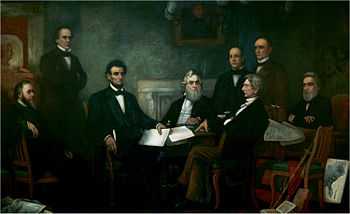
(People in the image are clickable.)
- ^ "Art & History: First Reading of the Emancipation Proclamation by President Lincoln". U.S. Senate. Retrieved August 2, 2013. Lincoln met with his cabinet on July 22, 1862, for the first reading of a draft of the Emancipation Proclamation. Sight measurement. Height: 108 inches (274.32 cm) Width: 180 inches (457.2 cm)
The president recognized Stanton's ability, but whenever necessary Lincoln managed to "plow around him". Stanton once tried to fire the Chief of the War Department Telegraph Office, Thomas Eckert. Lincoln prevented this by praising Eckert to Stanton. Yet, when pressure was exerted to remove the unpopular secretary from office, Lincoln refused. He said of Stanton:
| “ | He is the rock on the beach of our national ocean against which the breakers dash and roar, dash and roar without ceasing. He fights back the angry waters and prevents them from undermining and overwhelming the land. Gentlemen, I do not see how he survives, why he is not crushed and torn to pieces. Without him I should be destroyed. | ” |
| —President Abraham Lincoln[7], on Secretary of War Edwin M. Stanton | ||
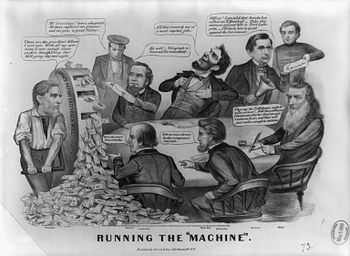
An 1864 cartoon featuring Stanton, William Fessenden, Abraham Lincoln, William Seward and Gideon Welles takes a swing at the Lincoln administration
Stanton became a Republican and apparently changed his opinion of Lincoln.
Lincoln's assassination
On April 15, 1865, Stanton rushed to the Petersen House, where President Lincoln had been taken after he had been shot at Ford's Theatre. The Secretary of War took charge of the scene. Mary Lincoln was so unhinged by the experience of the assassination that Stanton had her ordered from the room by shouting, "Take that woman out and do not let her in again!" At Lincoln's death Stanton uttered what became a memorable quote "Now he belongs to the ages" (or possibly "angels"), and lamented,[3] "There lies the most perfect ruler of men the world has ever seen." He vigorously pursued the apprehension and prosecution of the conspirators involved in Lincoln's assassination. These proceedings were not handled by the civil courts, but by a military tribunal, and therefore under Stanton's tutelage. Stanton has subsequently been accused of witness tampering, most notably of Louis J. Weichmann, and of other activities that skewed the outcome of the trials.
Andrew Johnson's administration
Stanton continued to hold the position of secretary of war under President Andrew Johnson until 1868. Stanton strongly disagreed with Johnson's plan to readmit the seceded states to the Union without guarantees of civil rights for freed slaves. The two clashed over implementation of Reconstruction policy, and Johnson dismissed Stanton and named Ulysses S. Grant as his replacement. The dismissal was overruled by the Senate. Stanton barricaded himself in his office when Johnson tried again to dismiss him, this time appointing Adjutant General Lorenzo Thomas as his successor. Radical Republicans initiated impeachment proceedings against Johnson on the grounds that Johnson's removal of Stanton without Senate approval violated the Tenure of Office Act. Stanton played a central role in the attempt to impeach President Andrew Johnson. Johnson avoided removal from office by a single vote in the Senate.[3]
U.S. Supreme Court appointment and death
After this, Stanton resigned and returned to the practice of law. He campaigned heavily for Ulysses S. Grant in 1868, and Grant rewarded him with an appointment to the U.S. Supreme Court in December 1869. The Senate confirmed Stanton on December 19. However, Stanton (whose health had worsened during the war), suffered a severe asthma attack on December 23, and died at 4:00 a.m. on December 24, 1869, in Washington, D.C.[8]
Stanton was buried at Oak Hill Cemetery in the city.[9] Because Stanton died before taking the oath of office, he is not considered to have officially joined the Supreme Court.
Personal life
On May 31, 1836, Edwin Stanton married Mary Lamson, and they had two children: Lucy Lamson Stanton (born March 11, 1837) and Edwin Lamson Stanton (born August 1842). They built a house in the small town of Cadiz, Ohio, where Stanton practiced law. Their daughter Lucy died in 1841 and their son Edwin died in 1877.
Mary Lamson Stanton died on March 13, 1844. The loss of his beloved wife sent Stanton spiraling into a deep depression. Then, in 1846, Stanton's brother Darwin cut his own throat – "The blood spouted up to the ceiling", a doctor recalled.
So many losses in so short a time changed Stanton, replacing a hearty good humor with a brusque, even rude, intensity. He moved to Pittsburgh, lost himself in legal work, and turned into a ferocious litigator. He also met and wooed Ellen Hutchison, who became his second wife and later survived him. While in Washington, Stanton worshipped at the Episcopal Church of the Epiphany, where he rented the pew vacated by Senator Jefferson Davis upon his resignation and secession.[10]
Stanton had taken a large pay cut to serve as Secretary of War, and his finances were not in good shape when he died. Congress voted Mrs. Stanton a sum the equivalent of one year's pension for a U.S. Supreme Court justice, since her late husband had been confirmed to the Court but not sworn in. Friends also collected a generous fund to care for her and her family.
Stanton on U.S. postage

Edwin Stanton was the second American other than a U.S. President to appear on a U.S. postage issue, the first being Benjamin Franklin, who appeared on a stamp in 1847. The only Stanton stamp was issued March 6, 1871. This was also the only stamp issued by the post office that year. The Stanton 7-cent stamp paid the single rate postage for letters sent from the U.S. to various countries in Europe.[11][12]
Legacy
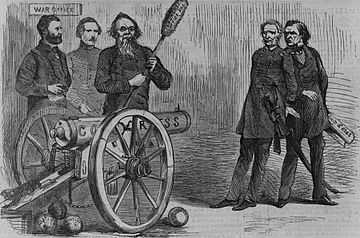
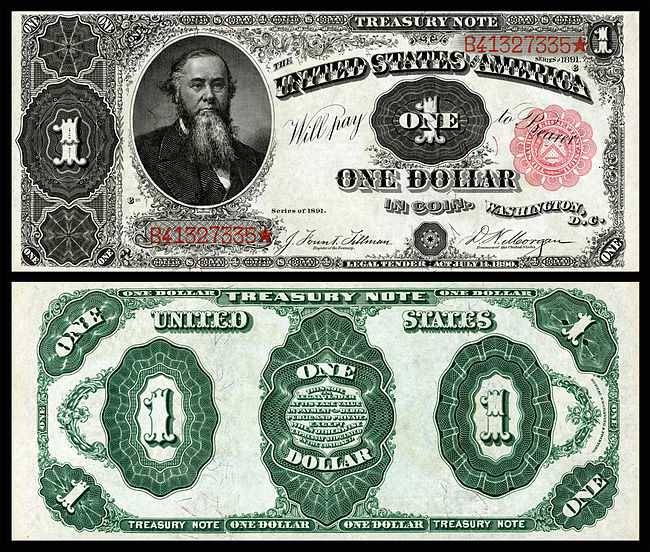
A distinctive engraved portrait of Stanton appeared on U.S. paper money in 1890 and 1891. The bills are called "treasury notes" or "coin notes" and are widely collected today. These rare notes are considered by many to be among the finest examples of detailed engraving ever to appear on banknotes. The $1 Stanton "fancyback" note of 1890, with an estimated 900–1,300 in existence relative to the millions printed, ranks as number 83 in the "100 Greatest American Currency Notes" compiled by Bowers and Sundman (2006). Stanton also appears on the fourth issue of Fractional currency, in the amount of 50 cents. Stanton Park, four blocks from the United States Capitol in Washington, D.C., is named for him, as is Stanton College Preparatory School in Jacksonville, Florida. A steam engine, built in 1862, was named the "E. M. Stanton" in honor of the new Secretary of War. Stanton County, Nebraska, is named for him. Stanton Middle School in Hammondsville, Ohio, is named after him. A neighborhood in Pittsburgh is named for him (Stanton Heights) as well as its main thoroughfare (Stanton Avenue).
The Edwin M. Stanton School (Jacksonville) in Florida and Edwin M. Stanton School (Philadelphia) are listed on the National Register of Historic Places.[13]
In popular culture
- In the 1930s, a book written by Otto Eisenschiml accused Stanton of arranging the assassination of Lincoln. Although these charges remain largely unsubstantiated, Eisenschim's book inspired considerable debate and the 1977 book and movie, The Lincoln Conspiracy.
- In 1930, Stanton was portrayed by Oscar Apfel in the movie Abraham Lincoln.
- In 1955, Stanton was portrayed by Richard H. Cutting in the movie The Gun That Won the West.
- In 1972, Stanton appears in Philip K. Dick's We Can Build You in the form of a self-aware, cybernetic automaton.
- In 1980, Stanton was portrayed by Richard A. Dysart in the TV movie The Ordeal of Dr. Mudd.
- In 1998, Stanton was portrayed by Eddie Jones in the TV movie The Day Lincoln Was Shot.
- Stanton appears prominently in the alternate history Civil War trilogy by Newt Gingrich and William R. Forstchen.
- Stanton Davis Kirkham was named after Stanton by his father, Murray S. Davis, one-time confidential military aide to Stanton during his period as Secretary of War.[14]
- In the Clive Cussler thriller novel Sahara, Stanton is described as being behind a cover-up of Lincoln's kidnapping and later death, in Confederate custody, aboard the ironclad CSS Texas. Lincoln's body is later recovered by Dirk Pitt and given a state funeral in the Lincoln memorial.
- In 2011, Stanton was portrayed by Kevin Kline in the Robert Redford film The Conspirator.
- Stanton was played by Bruce McGill in Steven Spielberg's film Lincoln.[15]
- Stanton is portrayed by Robert Craighead in another 2012 film, Saving Lincoln, which tells President Lincoln's story through the eyes of Ward Hill Lamon, a former law partner of Lincoln who also served as his primary bodyguard during the American Civil War.
- Stanton is portrayed by Matt Besser in the "Chicago" episode of Drunk History, created by Derek Waters on Comedy Central.
See also
- American Civil War
- List of United States political appointments that crossed party lines
- The Lincoln Cabinet
- The court-martial of Fitz John Porter
References
- ↑ "Edwin M. Stanton (1814–1869)". The Lincoln Institute. Retrieved December 18, 2010.
- ↑ 2.0 2.1 "Edwin M. Stanton". Ohio History Central. Retrieved December 18, 2010.
- ↑ 3.0 3.1 3.2 3.3 3.4 Robert C. Kennedy, Harper's Weekly. "The Impeachment of Andrew Johnson". Harper's Weekly. Retrieved December 20, 2010.
- ↑ 4.0 4.1 "Edwin Stanton2". Spartacus Educational UK. Retrieved December 18, 2010.
- ↑ Flower, Frank Abail (1905). Edwin McMasters Stanton, The Autocrat of Rebellion, Emancipation and Reconstruction. Boston, MA: George M. Smith & Co. p. 252 (footnote).
- ↑ Women of the Civil War, Wife of Secretary of War Edwin Stanton
- ↑ Swanson, James L. Manhunt: The 12-Day Chase for Lincoln's Killer. 6th ed. New York: Harper Collins, 2006. pp. 426–427. ISBN 978-0-06-051849-3
- ↑ Schroeder-Lein & Zuczek 2001, p. 276.
- ↑ Day & Hall 2005, p. 12.
- ↑ http://www.edow.org/about/the-diocese/about-the-diocese/history
- ↑ "Edwin M. Stanton issue of 1871". Smithsonian National Postal Nuseum. Retrieved December 18, 2010.
- ↑ Scott United States Stamp Catalogue
- ↑ "National Register Information System". National Register of Historic Places. National Park Service. 2010-07-09.
- ↑ Davis, Carlyle Channing (1916). Olden Times in Colorado. Los Angeles: Phillips Publishing Company. pp. 31–32.
- ↑ Jeanne Jakle (July 30, 2011). "Jeanne Jakle: McGill's profile going higher and higher". mysanantonio.com. Retrieved July 30, 2011.
Bibliography
- Bowers, Q.D., and Sundman, D.M., 2006, 100 Greatest American Currency Notes, Whitman Pub., Atlanta, GA, 134 p.
- Bissland, James. "Blood, Tears, and Glory". Wilmington, Ohio: Orange Frazer Press, 2007. Explains Stanton's key role in winning the Civil War.
- Day, Sandra Hudnall; Hall, Alan (2005). Steubenville. Charleston, S.C.: Arcadia Publishing. ISBN 0738533998.
- Flower, Frank Abial (1905). Edwin McMasters Stanton: the autocrat of rebellion, emancipation, and reconstruction. New York: Western W. Wilson.
- Goodwin, Doris Kearns. Team of Rivals: The Political Genius of Abraham Lincoln (2005) on Lincoln's cabinet.
- Harold M. Hyman, "Johnson, Stanton, and Grant: A Reconsideration of the Army's Role in the Events Leading to Impeachment", American Historical Review 66 (October 1960): 85–96, online in JSTOR.
- Hendrick, Burton J. Lincoln's War Cabinet (1946).
- Kunhardt, Dorothy Meserve, and Kunhardt Jr., Phillip B. Twenty Days. Castle Books, 1965. ISBN 1-55521-975-6
- Meneely, A. Howard, "Stanton, Edwin McMasters", in Dictionary of American Biography, Volume 9 (1935)
- Pratt, Fletcher. Stanton: Lincoln's Secretary of War (1953).
- Schroeder-Lein, Glenna R.; Zuczek, Richard (2001). Andrew Johnson: A Biographical Companion. Santa Barbara, Calif.: ABC-CLIO. ISBN 1576070301.
- Simpson, Brooks D. Let Us Have Peace: Ulysses S. Grant and the Politics of War and Reconstruction, 1861–1868 (1991)
- Skelton, William B. . "Stanton, Edwin McMasters"; American National Biography Online 2000.
- Stanton, Edwin (Edited by: Ben Ames Williams Jr.) Mr. Secretary (1940), partial autobiography.
- Thomas, Benjamin P., and Hyman, Harold M. Stanton: The Life and Times of Lincoln's Secretary of War (1962), the standard scholarly biography.
- William Hanchett The Lincoln Murder Conspiracies (1983); demolishes the allegation that Stanton was the center of the plot to assassinate Lincoln.
External links
| Wikiquote has quotations related to: Edwin M. Stanton |
| Wikimedia Commons has media related to Edwin McMasters Stanton. |
| Wikisource has the text of a 1920 Encyclopedia Americana article about Edwin M. Stanton. |
- Biography from "Impeach Andrew Johnson".
- Mr. Lincoln and Friends: Edwin M. Stanton Biography.
- Mr. Lincoln's White House: Edwin M. Stanton Biography.
- Pictures of Fractional Currency featuring Edwin Stanton, provided by the Federal Reserve Bank of San Francisco.
- Pictures of U.S. Treasury Notes featuring Edwin Stanton, provided by the Federal Reserve Bank of San Francisco.
- Spartacus Educational: Edwin M. Stanton.
- Stanton biography in Columbia Electronic Encyclopedia, 6th ed.
 "Stanton, Edwin McMasters". Appletons' Cyclopædia of American Biography. 1900.
"Stanton, Edwin McMasters". Appletons' Cyclopædia of American Biography. 1900.
| Legal offices | ||
|---|---|---|
| Preceded by Jeremiah S. Black |
U.S. Attorney General Served under: James Buchanan December 20, 1860 – March 4, 1861 |
Succeeded by Edward Bates |
| Political offices | ||
| Preceded by Simon Cameron |
U.S. Secretary of War Served under: Abraham Lincoln, Andrew Johnson January 20, 1862 – May 28, 1868 |
Succeeded by John M. Schofield |
| ||||||||||||||||||||||||
| |||||||||||||||||||||||||||||||
| |||||||||||||||||||||||||||||||
| |||||||||||||||||||||||||||||||
|

